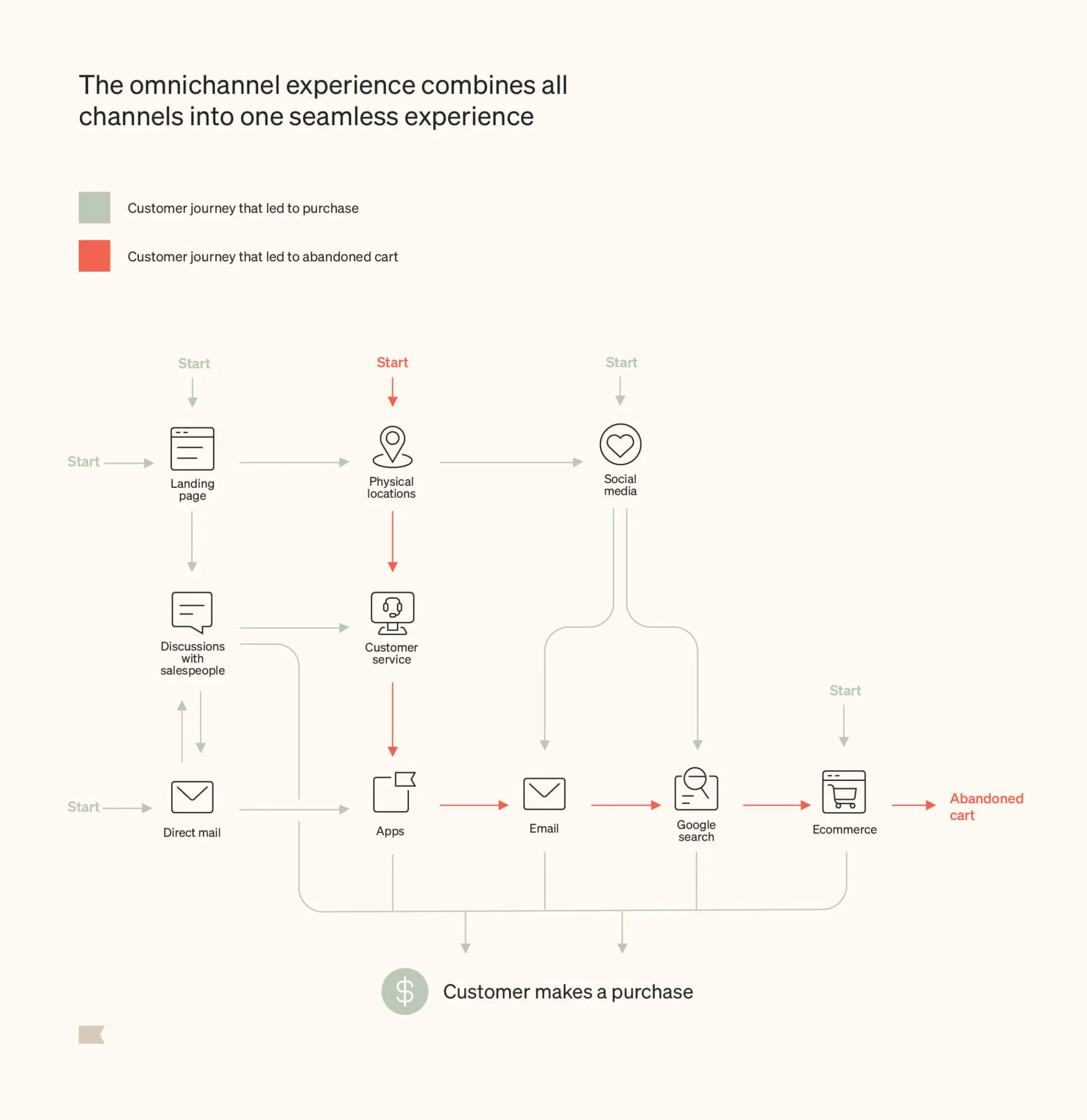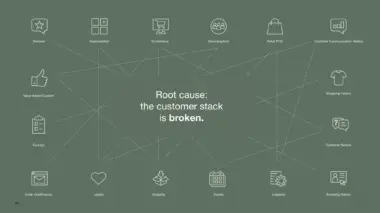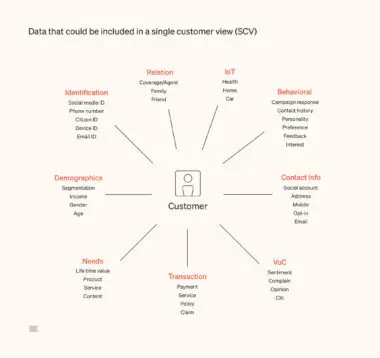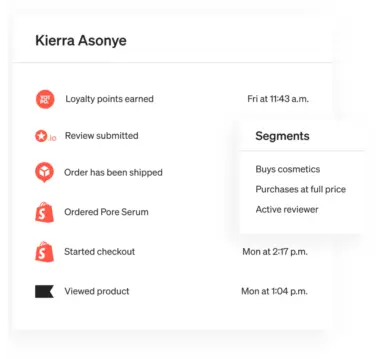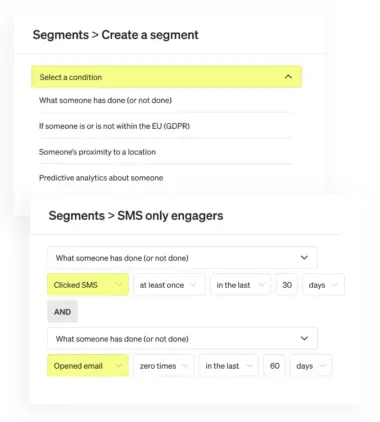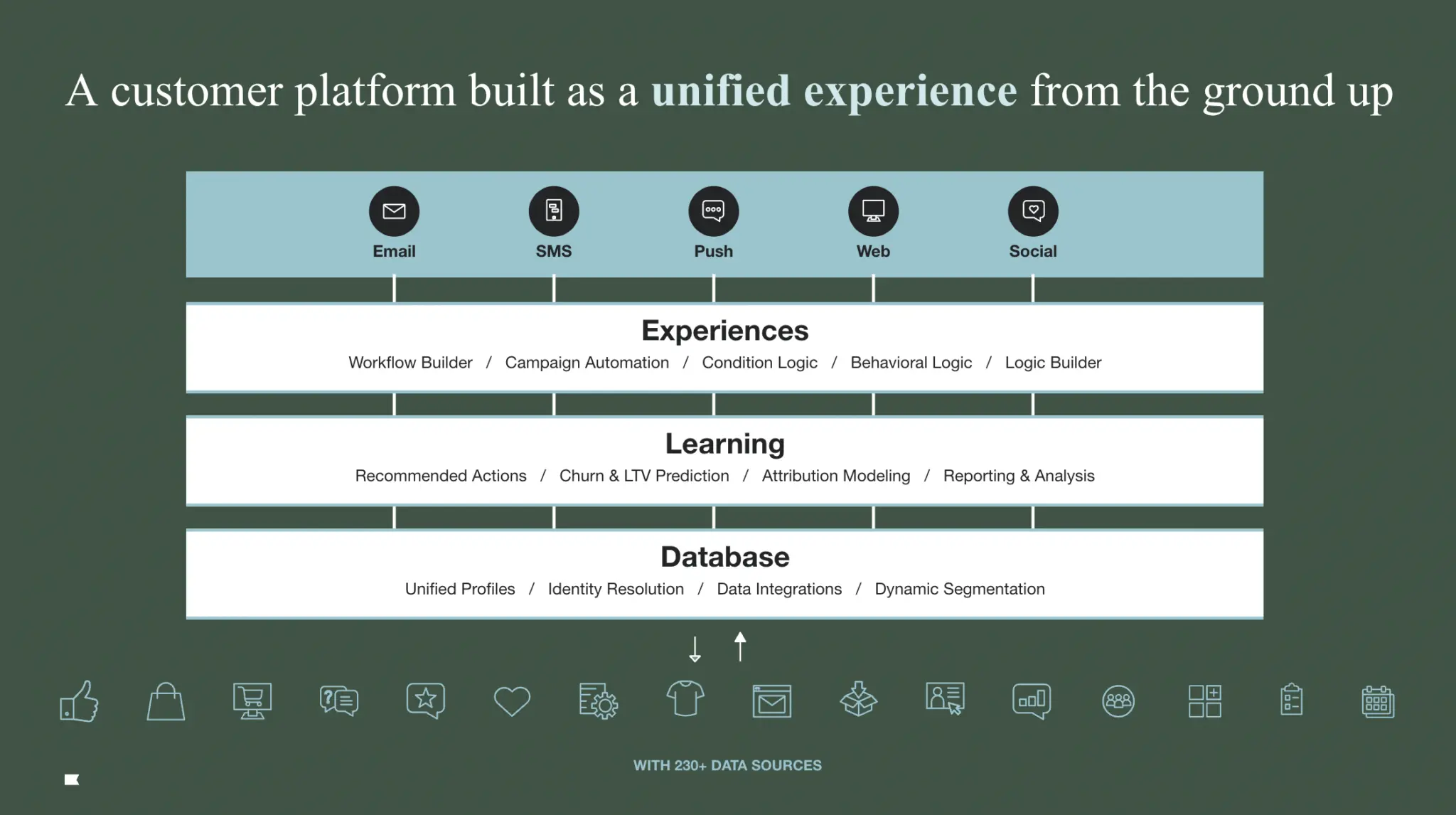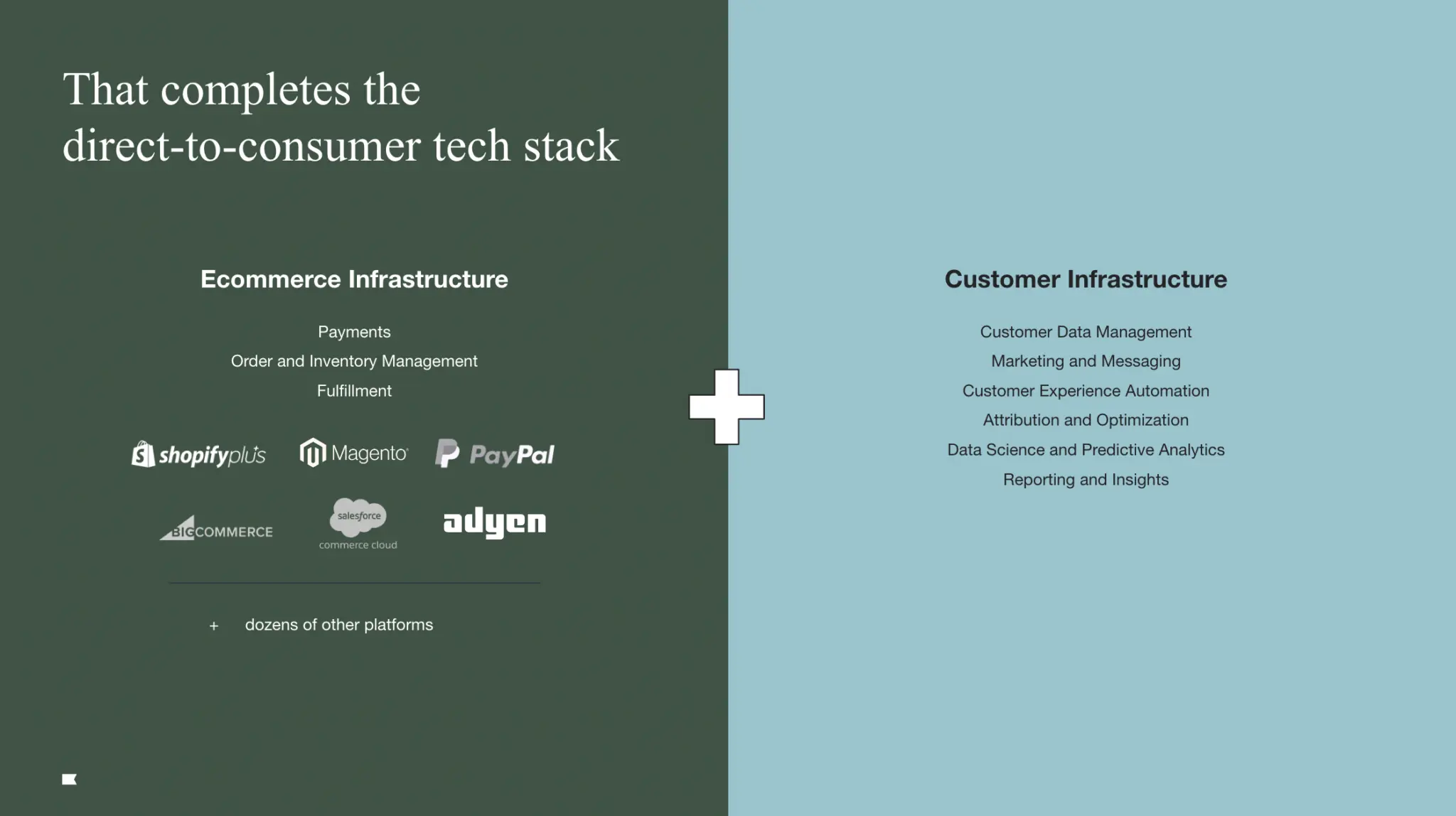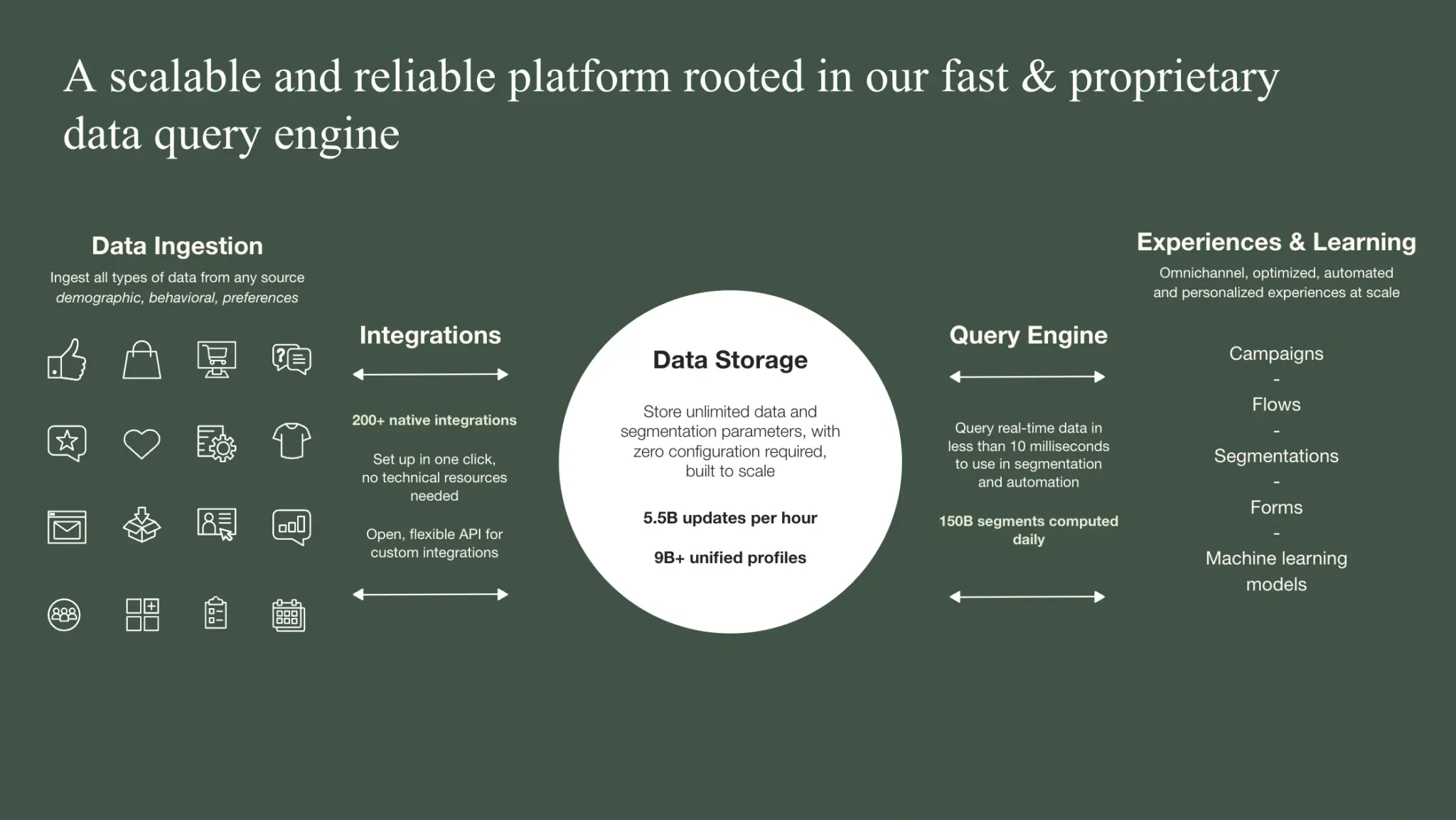The true cost of fragmented tech
Why retailers need a unified customer platform
Introduction
There is no denying the long-term benefit of delivering an omnichannel marketing experience.
It is what experts have long been calling a marketing flywheel, but to the extreme. Omnichannel marketing is how brands build customer experience strategies that improve acquisition, build loyalty, and drive retention, and reviews.
It’s exactly what brands like Graza, Sanzo, and Thirteen Lune have been able to do—build community and leave an impact on every channel they touch. This is hard to replicate, and especially so if you are using legacy marketing tools.
That’s because omnichannel’s evolution and progress has happened quickly, and not all technologies kept pace with that change.
What was table stakes for omnichannel technologies even just a couple years ago is no longer so. The needs and aspirations of the omnichannel shopper have simply evolved far too fast—especially during the global pandemic—and what was once table stakes is now traditional and restrictive.
For larger retail organizations built on legacy tech stacks, this means missing out not only on the newest marketing channels, but on the newest marketing strategies aimed at connecting with an always on, and everywhere consumer.
For the most part, those strategies are built around scalable personalization that uses constantly collected first- and zero-party data to segment customers and prospects based on similar traits and habits.
Then, to implement, marketing teams use dynamic content within those segments, creating what feels like a 1:1 personalization, but what is really a 1:many effort for the marketer. This is what makes omnichannel personalization scalable.
This type of personalization is being used in sign up forms, email marketing, SMS marketing, on landing pages, and more. But your team can’t act on this new model because the average mid-market retailer’s tech stack is broken.
These organizations often rely on custom builds or legacy technology which require up-keep expenses, high-levels of developer management, and in-depth training for marketing teams. Occasionally, a single-point solution can make it through procurement, but data doesn’t seamlessly integrate across legacy and newer tools, and single-point solutions often over-attribute the tool’s impact, anyway.
This leaves mid-market organizations between a rock and a hard place—especially as the global economy tightens and retailers look for ways to save money and maintain the bottom line.
Omnichannel solutions provide personalized, higher-converting and more loyalty-driving experiences, but the tools to create them are not the legacy systems mid-market retailers currently have in place.
The digital transformation of the last decade may have been about the move from on-premise to cloud and SaaS technologies, but the next era is here—and it’s about holistic experiences that require not just the collection of accurate customer data, but the activation of it, too.
You’ll need an integrated tech stack with a unified customer platform at its center. In the best case, this is a single tool rather than a handful of them, which then require syncing, coordination, risking data inaccuracy, and often come with a higher price tag to boot.
From a customer point of view, this integrated tech stack provides omnichannel experiences across a brand’s entire ecosystem that feel connected and seamless in delivery and capability.
That’s the thesis, at least, and we’re ready to back it up.
Dive into the sections on the left hand side for more research and in-depth analysis on the ever-changing omnichannel customer journey, and the integrated tech stack that best powers it for leading retailers.
About the author
Kunle Campbell is the co-founder at Octillion Capital Partners, an acquisition platform company liberating commerce founders with hassle-free exits. He is also an ecommerce advisor, international speaker and host of the 2X eCommerce Podcast, targeting mid-market retailers. Kunle has interviewed more than 300 retail executives. You can find and follow him on Twitter, here.
Today's omnichannel shopper
Who is the quintessential omnichannel shopper today? Fundamentally, this is a person who shops across multiple channels—and, critically, does so with ease.
Unlike shoppers just a few years ago who might have switched between a few channels at most and only on rare occasions, channel-savvy shoppers today are able to seamlessly switch channels, and do so often.
Channel-hopping is the key attribute of omnichannel shoppers.
They are not fazed by switching between, say, a personalized offer on a retail website coupled with a push notification via their browser or app, followed by an email update prompting them to make a local in-store pick-up. Once in-store, they may browse an interactive catalog to make further purchases.
A Forbes article noted this trend in late 2021, stating, “The average consumer is no longer using only two touch points per purchase; it has now tripled to six.”
McKinsey puts it even more starkly by declaring, “Omnichannel is now a ten-channel world. Five years ago, being omnichannel meant offering four or five channels. Now our data shows that customers want—and expect—to engage seamlessly across ten or more.”
Again, these shoppers channel-switch with ease and with the expectation that many channel options are open to them at all times of the day. For these shoppers, this channel-switching translates to the freedom of choice in how to order and receive their purchases, not just quicker but also more conveniently.
Another attribute of today’s omnichannel shopper is that they know how to shop and have the means to do so. This is backed up by studies estimating that shoppers who interact with multiple channels are likely to spend 18 to 36% more than single-channel shoppers.
That is a significant difference in purchasing power that any omnichannel marketer must capitalize on. To do so, these marketers need to create a seamless omnichannel shopping experience. And the urgency to create this experience is only on the rise.
Omnichannel shopping is here to stay
What was the number one trend that emerged from a September 2021 survey of over 7,000 retailers regarding shopping trends in the United States?
In the report’s own words: “The future of shopping is omnichannel shopping.”
Now, more than 2.14B people worldwide—roughly 30% of the global population—are shopping online, according to a survey undertaken by Forrester Consulting for Shopify.
And while those ecommerce numbers are impressive, there is an interesting twist to the omnichannel evolution that not many pundits predicted a few years back. It has to do with the continued popularity of brick and mortar shopping, which is seeing an upsurge of popularity, and not just since the end of the pandemic.
Consumers head back to in-store
Even younger shoppers were not as against brick and mortar shopping as many marketers and retail analysts assumed.
A Forbes article cautioned against the predicted “inevitable collapse” of physical stores early in 2020, arguing, for example, that younger shoppers were not as against brick and mortar shopping as many marketers and retail analysts assumed.
So, what happened to halt and even reverse this “inevitable collapse?”
Post-pandemic, there is one big reason why physical stores are seeing an uptick in traffic: After months of mandatory lock-downs and social distancing due to coronavirus, many customers realized they missed the physical and tactile experience of being inside a shop.
Even Shopify noted this shift in late 2021, stating, “Consumers are hungry for in-person shopping experiences and the camaraderie that comes with them.”
Still prior to the pandemic, there was an error in thinking in the retail industry. Ecommerce and brick and mortar stores are not independent of one another, as has often been touted. They are complimentary channels in an omnichannel environment, rather than silo-ed channels in a multi-channel environment.
This difference is important, and is based on consumer behavior rather than how retailers might prefer to internally structure teams.
And today, the pressure on retailers for holistic omnichannel experiences is indeed a customer-driven one, based on shoppers’ preferences and the die-hard habits they have developed throughout the omnichannel retail evolution.
Just look, for example, at the Buy Online, Pick-up In-Store (BOPIS) or click-and-collect option for shoppers.
Business Insider reported in May 2021 that shoppers in the U.S. spent $72.46B on click-and-collect purchases in 2020, an astounding 106.9% growth rate compared to 2019.
Yes, 2020 was the height of the pandemic, but signs in 2022 point to people continuing to opt for click-and-collect, which pushes more and more people back into the physical store. Business Insider predicts that click-and-collect will grow in the U.S. from 143.8M people in 2020 to over 160M in 2024.
The channel-agnostic shopper, and how they alter your internal team structure
The word ‘agnostic’ traditionally has a religious connotation. In a non-religious context, the word refers to someone having a doubtful or non-committal attitude toward a given thing or issue.
In reference to omnichannel marketing, channel-agnostic refers to a shopper who is simply not biased to any one channel or type of shopping experience. Instead, their focus is on the shopping experience itself, no matter what the particular channel or channels to attain that experience might be.
The consumer journey is not linear
With the channel-agnostic, the emphasis is on a positive customer journey—nothing more and nothing less.
To no surprise, these customers don’t actually care too much about which specific channels they use to engage with your brand and products. With the channel-agnostic, the emphasis is on a positive customer journey—nothing more and nothing less.
While the channel-agnostic shopper is a subset of the omnichannel shopper, there is one big difference between these two groups: the channel-agnostic demands more of the retailer and marketer. This is because if channel differentiation is entirely unimportant, then all channels should offer the user the same, seamless experience or buying journey.
For the channel-agnostic, channels can be both funnels to more information—more in line with traditional marketing funnels—or an entire buyer’s journey itself—completely eliminating the use of any other channel. Creating channel-specific experiences that tell a brand’s entire story and offer top of funnel through to bottom of funnel experiences is not how most marketers, their teams, or their tools are set up to work.
How can brands and marketers, then, match the expectations of the channel-agnostic shopper? A few ways:
- Focus on the entire customer journey as a holistic experience: Think of your customer experience like a neighborhood. If someone wants to go into one house and only experience what is there—that is their right, and they will have a holistic neighborhood experience there, even if they never venture out. Build the inside of that house as part of the overall experience, and enough to sustain someone even if they see nothing else.
- View individual channels as part of a collective whole: This is your omnichannel hive, or your entire neighborhood. Each house is a channel. It functions both on its own, but adds value to the overall neighborhood experience. Together, all houses, and all channels, add up to an overall experience that encourages—or not—community, loyalty, purchasing, and more.
- Realize definitively that customers who are channel-agnostic do not have channel preferences, including how or where they make purchases, as well as interactions with your brand or products. This means that consumers don’t care if they are buying your product in Target or on Amazon or on your website. All that matters is if you are or are not on the shelf, or have or don’t have that website. Legacy brands historically opted out of selling online, for instance. Direct-to-consumer brands opted out of selling wholesale. Today, everyone must be everywhere, and do it all. There is no opting out of a channel in which a purchase could happen.
- Ensure that marketing competencies focus on all channels, rather than having ‘specialized’ marketing strategies and marketing professionals for specific channels. Lean marketing teams are often built best with experienced marketing generalists who can strategize on a holistic customer experience. Need expertise in a specific area? Hire a consultant to help.
- Explore and invest in a tech stack that enables greater seamlessness between channels: For most mid-market retailers, this will mean tech stack consolidation. You need a central source of truth and the ability to build and act on a single customer view (SCV), which we’ll cover more in a moment. There are procurement issues to consider here, as well as platform functionality. Developers and tech teams need strong and capable APIs to customize platforms as the business demands, and marketers need platforms they can use easily and quickly to spin up campaigns and drive revenue.
- Analyze CX data in order to assess potential weak spots in customer journeys, as well as trends within journeys: Historically, the customer experience has been viewed through a lens of support and quick ticket reconciliation. No longer. Your marketing funnel—all the way down to retention, cross-selling and up-selling—is your customer experience journey. Where is it falling apart? Do you have the data available to answer that question? Even if you do, can you act on that data quickly to test ideas and see if you can close the gap? This is what your omnichannel tech stack should enable.
The challenge of delivering an omnichannel experience
Omnichannel experience delivery has evolved and seen enormous growth and adoption over the past few years. Yet, there are serious challenges that thwart further or sustainable growth.
Marketers and brands alike are discovering that omnichannel experience deployment options can be strategically confusing, with success not always guaranteed.
The failure to capitalize on customer-oriented omnichannel experiences should be a concern to any marketer or brand. There are huge benefits to personalized omnichannel offerings, with customer retention rates as much as 90% higher compared to experiences from a single channel.
How to deliver on an omnichannel customer experience
It is one thing to say your brand delivers an omnichannel experience, and quite another to actually deliver on that promise.
Yet, few brands have recognized such value from their omnichannel experiences, and that is because it is one thing to say your brand delivers an omnichannel experience, and quite another to actually deliver on that promise.
The reality is that most mid-market and enterprise consumer brands struggle to deliver personalized, omnichannel experiences at scale. Why? Because their customer tech stack is broken.
Moreover, mid-market retail tech stacks weren’t built for customers, at all. Today’s legacy tech stacks were first built for an era of security, with APIs and other developer-first or IT-first functionality prioritized in the platforms. This has long left marketers behind, as slow-moving departments in their organization, unable to own their success effectively.
More recently, tech solutions have focused on attribution, working to earn more of your company’s investment dollars as they prove their tool can generate the most revenue for your brand.
You saw this happen with Facebook—which was attributing sales made 30+ days after a consumer saw an ad back to their platform. When Facebook was forced to implement a 7-day attribution window, the company saw a $232B revenue loss.
These attribution-first platforms were built for the multi-channel experience, in which marketers needed to figure out which channels were the most important and which to cut. While internal conversations in retail marketing departments may still focus on this, the shopper has evolved, and in many cases has lost faith in retailers who only use one or two channels.
The omnichannel experience builds trust, builds brand, and delivers on experience first for the customer, rather than attribution first for the marketer.
What is the first step in building that high-quality omnichannel experience? Personalization.
Research in 2021 found that customers have veered away from their previous concerns regarding how and what personal data brands were collecting from them. Now, customers are focused instead on when and how brands are using their collected data in order to present them with offers and promotions that are consistent and relevant to them.
Customers want a CX that speaks directly to them and their shopping needs, every time. In a nutshell, personalization rules. Yet, brands of all sizes have had a difficult time personalizing communications and experiences with consumers on a 1:1 basis and at scale.
63% of digital marketing leaders still struggle with personalization.
The findings from a 2021 Gartner survey revealed that as many as 63% of digital marketing leaders still struggle with personalization. This is not helped by the fact that only 17% of marketers use artificial intelligence (AI)I and machine learning (ML) to enhance and boost needed cross-functionalities.
This is even as, according to Gartner, “84% of digital marketing leaders believe using AI/ML enhances the marketing function’s ability to deliver real-time, personalized experiences to customers.”
This is clearly not happening as often as required.
Most brands simply do not have a full grasp and understanding of the entire customer journey. This is because their customer data is often siloed and fragmented with limited congruence. And, use of single-point solutions has caused over-attribution for newer channels, distorting a team’s understanding of how their marketing funnel functions.
A clear understanding as to why this is happening in most omnichannel experience deliveries is required.
The 6 points of failure to legacy tech stacks
As you can see, your tech stack is at the core of omnichannel planning and customer experience delivery. Yet, that tech stack often doesn’t help marketers build and distribute those experiences.
These breakdowns are due to complex solutions or legacy technologies that are too often expensive, glitchy and costly to maintain and customize, and that often require additional effort and time. Many require months of implementation even for relatively easy marketing campaigns or tactics.
Let’s look at 6 points of failure to typical legacy tech stacks in ecommerce, and how those points of failure affect your marketing team and your bottom line.
Omnichannel solutions, and those built for marketing technology generally, are simply too complex or confusing for marketers a lot of the time.
This has been borne out by studies that have shown that as much as 42% of MarTech capabilities are not utilized due to the following factors, according to marketing respondents, of which a significant portion relates to the complexity factor:
- 23% say they buy a lot of solutions but simply cannot use the features
- 21% say the complexity of their current overall MarTech stack is to blame
- 26% say this is due to a lack of cross-functional collaboration
The omnichannel marketer’s goldmine: the single customer view
If personalization is the ‘nirvana’ for marketers in today’s omnichannel reality, then having as much congruent information as possible for each customer is paramount.
The single customer view (SCV) should be your dashboard to beat all dashboards: a single dashboard that displays all the personal data for a given customer.
There is a reason why it is also referred to as the Customer 360 View (C360) or Unified Customer View (UCV) since the dashboard should provide you with a complete snapshot of a customer’s personal details, preferences, purchases, and so forth.
All communications between customers and your brand should be instantly available via the dashboard. So too should all their activities with loyalty programs, and any other touchpoint in your marketing tech stack that enables a better understanding of their shopping habits and overall shopper profile.
The sheer scale and scope of this insight into a customer can be seen below (Courtesy: APAC CIO Outlook):
There is a reason why SCV is considered the ‘holy grail’ for digital marketers and brand leaders. It paints an exacting, multi-faceted portrait of the customer and, importantly, how they tend to behave. SCV speaks precisely to personalization since it offers a 1:1 connection between brand and customer.
SCV further allows for more effective and customer-relevant segmentation based on key factors including collected first and zero-party data like:
- Lifetime purchase history and predicted CLV
- Communication channel subscription (email, SMS, etc) and engagement on those channels
- On-site activity, and the UTMs that drove that activity
- Geographic location
- Product preferences
- History of enrollment and engagement in customer communication flows and automations
- Enrollment in loyalty programs, and specified tiers
- Individual birthday and the anniversary of first purchase with the brand
- Product reviews and any collected UGC
- Preferential data collected through surveys or quizzes
Importantly, SCV helps marketers make sense of the overwhelming amount of personal data about a customer that has been amassed from any omnichannel undertaking.
So, what’s happening that brands don’t have access to their view, or if they do that they can’t act upon its insights?
The broken single customer view in most omnichannel tech stacks
It may seem extreme to declare the single customer view (SCV) as “broken” but in many ways it is.
Brands continue to struggle to fully understand their customers within genuinely holistic, 1-on-1 relationships, despite data about that customer streaming in from across various channels, applications and different segments of their customer journey.
So, while the data may exist within tech stacks, rarely is it presented in a clear, concise and actionable way for marketers working within that omnichannel tech stack.
Here are the three reasons often cited by data experts for this breakdown in an SCV strategy:
- Poor data quality: Not all data is equal. A lack of clear focus on personalized omnichannel experiences means that marketing teams may not have access to customer information that is specific and easily prioritized. Not all tools collect and store data in a way that a marketer can clearly understand, and build plans off of. Many tools overwrite data overtime, and many marketers fail to understand the ways in which data flows into their tools and systems, creating confusion about the best path forward.
- A siloed multi-channel strategy: Many marketing teams will have biases toward certain channels, even if not expressly so. This is especially prevalent where the skills sets within marketing teams are predominantly within certain channels, such as with email funnels or paid social media marketing. The result is other channels being undervalued and a lack of integrated, seamless channel offerings for customers. Legacy tools often encourage this, since they have been built for multi-channel attribution, rather than holistic omnichannel attribution.
- Unconnected technologies: As omnichannel marketing matures and evolves, so too will the proliferation and sophistication of the technologies that power it. This can be understandably overwhelming for marketers who may not be tech-savvy, struggle to keep abreast of technological advances, or use far too many tools rather than a unified system.
Learn about Klaviyo’s cooperative attribution model, one of the industry’s most conservative
The cooperative last touch model is an evolution of last touch attribution that takes two or more channels into account. These channels are often used synchronistically by the marketer and are generated from the same marketing technology tool. This is a useful model when different channels have different attribution windows and a marketer wants to make sure the activity that actually inspired the purchase is the one that gets the credit, regardless of which happened first.
Learn more about the different marketing attribution models and metrics, here.
A reimagined, enterprise omnichannel tech stack
Let’s look at what is really needed for omnichannel experience delivery today, which is an integrated tech stack with a unified customer platform at its center.
This should complete the direct-to-consumer tech stack by combining ecommerce infrastructure with customer infrastructure across both digital and physical touchpoints.
An omnichannel tech stack marketing teams want to use
A customer-first tech stack must be the focus of marketing teams serious about delivering and optimizing omnichannel experiences.
Your solution of choice should enable enterprise-grade personalization that scales and optimizes, easily allowing your marketing team to build unparalleled omnichannel customer experiences without overwhelming your team with unending 1:1 personalization tasks.
To do this, data integration and implementation is vital. The chosen solution needs to help your marketers validate data integrity and performance, and offer pre-built and tested integrations that can quickly pass procurement and don’t add weeks of development work to the project.
Finally, your marketing team needs fast and accessible speed of execution. They require a solution that can ingest millions of transactional data points in minutes with a marketer-friendly user interface. This means the team should be able to easily query data in real-time to be used in effective segmentation and automation of personalized communication with customers.
Scalable personalization via segmentation & dynamic blocks
Personalization in omnichannel marketing today is everything. Your customer needs to be front and center. It is not the channels that count, but the customer and their experience. Everything flows from that.
Your marketing team then needs a tech stack that helps them build, and automate personalized experiences that increase engagement and, together, create an omnichannel CX.
In tandem, your solution needs to be able to scale repeat purchases from those customers already acquired by putting the customer journey on autopilot with flexible and extensible automated flows.
These should be organic and constantly evolving. Who wants to go on the same journey each time?
These personalized, autopilot flows are built using powerful customer segmentation based on their single customer view data and dynamic content blocks.
This allows your marketers to create 1:many personalized automations that present as 1:1 experiences for the customer. For example, Klaviyo offers an open-source tagging scheme—named Django—for dynamic content personalization across the majority of data in your SCV.
With segmentation and dynamic content blocks, your autopilot programs should:
- Offer personalized product recommendations based on machine learning (ML) that can show the right product at the right time to a given customer.
- Continuously collect additional zero-party data via surveys and quizzes that are added to the SCV, and can be used to create even more personalized segments and automations.
This is enterprise-grade and enterprise-wide personalization that works and builds experiences at scale, based on a customizable and reliable platform rooted in a fast and proprietary data query engine. This means your teams can cease having to cobble together platforms in an ad-hoc, chaotic way that fails to deliver marketing opportunities for segmentation, personalization, and optimization.
Infrastructure that balances data collection & speed to market
Integration is the nexus between your ecommerce tech stack infrastructure and the entirety of all customer data that your channels accrue. As such, your omnichannel database needs to possess the following:
- Unlimited data storage and retention
- Unstructured data storage
- Native integrations that work and are easy to set up and test
- Cross-channel identity resolution
- Deep and fast segmentation
- Single customer view data storage allowing easy segmentation with zero configuration required, built to scale
- The ability to ingest all types of customer data—such as demographic, behavioral, buyer preferences, etc.—from any source
A platform should also deliver real-time data that can be queried in seconds, so that automations can be triggered almost immediately. For example, Klaviyo’s query engine can query real-time data in less than 10 milliseconds, which can then be used in segmentation and automation.
To do all of this, a tech tool needs to have built a unified, customer-focused, and interrelated database. Below, you can see Klaviyo’s:
APIs for customization as you grow and expand
Hundreds of direct integrations are built-in to modern omnichannel tech tools, but APIs allow your team to integrate with anything you want, so that the tech can get out of the way as you build the customer experiences necessary to succeed.
Klaviyo’s open APIs, for example, give your team the flexibility to integrate with just about any system that exports data. Customization is also a key offering, including:
- Custom triggers: Customize the form code to trigger forms using custom buttons or actions.
- Custom catalog: Leverage personalized product recommendations by syncing your custom catalog to Klaviyo.
- Custom event tracking: Define any activity and track it within Klaviyo. Use these events to trigger messages through flows or for custom reporting
The result is a modern ecommerce customer infrastructure dichotomy that is in sync with industry best practices, but that allows you to build unlimited, customized experiences however you want.
Always secure and compliant with industry standards
Security is of course critically important for this type of complex infrastructure.
Modern omnichannel tools offer industry-leading 3rd party audit certifications, such as SOC2, which is a voluntary compliance standard for service organizations, as developed by the American Institute of CPAs (AICPA).
These companies are also benchmarked against ISO 27001, the leading international management system standard on how to manage information security.
Klaviyo, in particular, is also a member of industry trade associations for both email and SMS responsible for self regulating the space.
A foundation for omnichannel now, and whatever comes next
Unsurprisingly, your database needs to include the very best in current and evolving smart technologies, otherwise it is destined to become one of the legacy solutions mentioned above, with all the same issues.
Klaviyo is one such modern omnichannel tech tool, and the company has built up a team of more than 40 data scientists who have woven true AI and ML throughout the platform based on the largest ecommerce and retail-focused data set of which I am aware.
Features within the platform that use this AI and ML are:
- Automated A/B/n testing
- When to send your message
- Peer benchmarking
- Churn and lifetime value (LTV) predictions
Here are a few other attributes of the Klaviyo omnichannel platform:
- Built on a modern schema-less database, thereby requiring zero configuration
- Built for high performance and massive scale, e.g. billions of data points are created per day that can be processed with ultra-low-latency
- Built to support streaming data that trigger segmentation and automations in real-time
How to lower total cost of ownership before it’s too late
All of this sounds great, but price tags stop many organizations in their tracks. It isn’t just the cost of the platform itself, but also the cost of migration, any down time, and more.
Indeed, total cost of ownership continues to be one of the leading hurdles to omnichannel optimization.
The rising costs of omnichannel experience technologies, in particular due to the escalating costs of digital channels, mean that brands need to make every effort to ensure their TCO is lowered.
Digital transformation, including Marketing Automation Platform (MAP), Customer Data Platform (CDP), and the implementation of new channels, all require investment, which include their implementation, applicable licensing, training and utilization costs. These costs can sometimes surpass six figures.
The way to lower these costs is to invest in a smart, customized omnichannel platform—and consolidate your tech stack where you can.
Pitfalls to look for when demoing new solutions
Your chosen platform needs to add value from day one, and should be fast to set-up, implement, and generate revenue.
What you don’t want is any omnichannel option that has the following
- Having to buy before trying it out: Look out for trials or ask a rep after a customized demo to set up an account you and your team can use to look around for at least two weeks.
- Long term contractual lock-ins: You don’t want to update your tech stack every year, but very long-term contractual lock-ins can signify a company’s lack of innovation for the future, and you don’t want to be stuck.
- Limited data storage: You want just as much or more than you have now on your existing systems.
- Lack of APIs or a limited number of API calls: Have your development team work with thee to test their true capabilities, or ask for same-size company referrals and do your due diligence with those teams.
- Complex integrations: Have both your marketing team and your development team test out integration possibilities, quality and speed before buying.
- Clunky software: Have you marketing team test out this tool before buying.
- Stagnating returns: Ask for same-size customer referrals and do your due diligence here.
Instead, look for tools that allow you to:
- Test the tool with your own data before having to purchase and commit
- Benefit from flexible and transparent pricing
- Build custom integrations with open APIs
- Not be caught by unexpected data limits
- Drive a multi-channel marketing experience built on a unified platform that can address both omnichannel shoppers and the channel-agnostic ones.
Look, too, at ease of use in every platform you demo—and ask for trial runs where you can so that your larger team can test it out. Many enterprise platforms lack clear UX, stalling marketing and sales teams, and causing bureaucratic complexity.
In the end, as with so much in business, it’s all about making the right choice.
For your omnichannel strategy and operational needs, now is the time to modernize and consolidate your tech stack into something that enables omnichannel customer experiences at scale. That is the future of retail, and one of the best ways to empower your marketing team to succeed.
They need a platform that can personalize communications with your customers at scale, easily acquire new ones, and, of paramount importance, use your owned data to drive revenue across all channels.
About Klaviyo
Klaviyo is a world-leading marketing automation platform dedicated to accelerating revenue and customer connection for online businesses. Klaviyo makes it easy to store, access, analyze and use transactional and behavioral data to power highly-targeted customer and prospect communications. The company’s hybrid customer-data and marketing-platform model allows companies to grow by fostering direct relationships with customers, without giving up their valuable data to popular big-tech ad platforms. Over 265,000 innovative companies like Unilever, Custom Ink, Living Proof and Huckberry sell more with Klaviyo. Learn more at www.klaviyo.com
